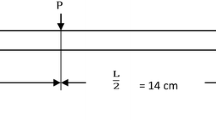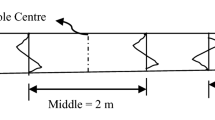Abstract
The study was conducted to evaluate variations in selected mechanical properties of B. aethiopum. Fifteen B. aethiopum trees from savanna zones in Nigeria were sampled at the base (10%), middle (50%) and top (90%) of the merchantable length and partitioned into outerwood, centrewood and innerwood along the radial plane. Selected strength properties such as impact bending strength (IMB), modulus of elasticity (MOE), modulus of rupture and maximum compressive strength parallel to grain (MCS//) were evaluated. Data were analysed using descriptive statistics and ANOVA at a 0.05. The IMB at base was (22.46 ± 0.07 kJ/m2), middle (20.38 ± 0.08 kJ/m2) and top (11.68 ± 0.0 kJ/m2). The MOE was 14,365.96 ± 284.74 N/mm2, 13,242.54 ± 525.83 N/mm2 and 12,066.129.03 N/mm2 at the base, middle and top, respectively, and the MOR was 130.96 ± 1.06 N/mm2 at the base, 102.98 ± 1.30 N/mm2 at middle and 70.56 ± 1.03 N/mm2 at top. The MCS// decreased from 59.79 ± 16.95 N/mm2 at the base to 45.18 ± 29.16 N/mm2 at the top. Radially, all the parameters assessed (IMB, MOE, MOR and MCS//) decreased from outerwood to the centrewood and further to the innerwood. It is therefore concluded that B. aethiopum mechanical properties were superior at the base and outerwoods. It has the potentials required by construction industries to substitute the primary timber species.




Similar content being viewed by others
References
Acheampong JB (2014) Physico-chemical properties and natural durability within two varieties of Borassus aethiopum. Dissertation, Kwame Nkrumah University of Science and Technology, p 133
Adedipe OE (2004) Machining and mechanical properties of plantation grown Gmelina arborea wood. Dissertation, Federal University Technology, Akure, p 81
Akira T (1978) Compilation of data on the mechanical properties of foreign woods. No 7, Part III (Africa). January, 1978. A monograph published by Matsue, Shimane University
Arancon Jr RN (1997) Asia-pacific forestry sector outlook study working papers: focus on coconut wood. Working paper no. APFSOS/WP/23. FAO paper October 1997, pp 1–36. www.fao.org/forestry/en
Asafu-Adjaye OA, Frimpong MK, Darkwa NA (2013) Assessment of the effects of density on the mechanical properties variations of Borassus aethiopum. Sch Res Libr Arch Appl Sci Res 5(6):6–19
Ayarkwa J (1997) Potential for the utilization of Borassus aethiopum (Fun Palm) in construction in Ghana. Forest Research Institute of Ghana. WOOD, January–March 1997, pp 15–18
British Standards (BS) 373 (1957) Method of testing small clear specimens of timber. British Standard Institute, London, p 32
Desch HE, Dinwoodie JM (1983) Timber: its structure, properties and utilization, 6th edn. Macmillan Education, London
Forest Products Laboratory (2010) Wood handbook—wood as an engineering material. General technical report FPL-GTR-190. U.S. Department of Agriculture, Forest Service, Forest Products Laboratory, Madison, p 508
Lausberg MJF, Cown DJ, MacConchie S, Skipmith JH (1995) Variation in some wood properties of Pseudotsuga menziesii provenances grown in New Zealand. N Z J For Sci 25(2):133–146
Mijinyawa Y, Omobowale MO (2007) Determination of the moduli of elasticity and rupture, and impact energy of oil palm trunk. Adv Agric Eng 1(4):26–33
Ogunsanwo OY (2000) Characterization of wood properties of plantation grown obeche (Triplochiton sceleroxylon. K. Schum) in Omo Forest Reserve, Ogun State, Nigeria, dissertation. University of Ibadan, p 253
Ogunsanwo OY, Terziev N, Elowson T (2007) Evaluation of physical and mechanical properties of two lesser known hardwoods from Nigeria. J Trop For Resour 23(1):28–36
Oluwayemisi TA (2002) Study of some selected physical and mechanical properties of Calistemon rigidus. (R.Br). Dissertation, University of Ibadan, p 64
Panshin AJ, de Zeeuw C (1980) Textbook of wood technology, 4th edn. McGraw-Hill, New York, p 722
Salako FK (2003) Soil physical conditions in Nigerian savannahs and biomass production. Lecture given at the College on Soil Physics Trieste, Department of Soil Science and Agricultural Mechanization, University of Agriculture, Abeokuta, Nigeria. 3–21 Mar 2003, pp 365–377
Sanon M, Sacande M (2007) Seed leaflet. Borassus aethiopum mart. no. 120 September 2007. Forestry and land scape. Millennium Seed Bank Project. www.kew.org/msbp
Sanwo SK (1983) Variations in the wood characteristic of plantation grown teak (Tectona grandis) in Nigeria. Dissertation, University of Wales, p 287
Shrivastava MB (1997) Wood technology. Vikas Publishing House PVT LTD, New Delhi
Shupe TF, Hse CY, Choong ET, Groom LH (1997) Effect of silvicultural practice and moisture content on loblolly pine veneer mechanical properties. For Prod J 47(11 and 12):92–96
StatSoft Inc (2004) STATISTICA (data analysis software system), version 7. www.statsoft.com
TEDB (1994) The tropical timbers of Ghana. Timber Export Development Board, Takoradi, p 87
Upton DAJ, Attah A (2003) Commercial timbers of Ghana—the potential for lesser used species. Forestry Commission of Ghana, Accra, p 56
Acknowledgements
The author is grateful to International Tropical Timber Organisation (ITTO) for the support provided for this study through the Grant 2010/ITTO Fellowship award ref: 119/10S.
Author information
Authors and Affiliations
Corresponding author
Ethics declarations
Conflict of interest
The corresponding author states that there is no conflict of interest.
Additional information
Publisher's Note
Springer Nature remains neutral with regard to jurisdictional claims in published maps and institutional affiliations.
Rights and permissions
About this article
Cite this article
Ojo, A.R. Determination of the utilization potentials of the wood of Borassus aethiopum Mart. through its strength properties. J Indian Acad Wood Sci 17, 123–130 (2020). https://doi.org/10.1007/s13196-020-00263-z
Received:
Accepted:
Published:
Issue Date:
DOI: https://doi.org/10.1007/s13196-020-00263-z




